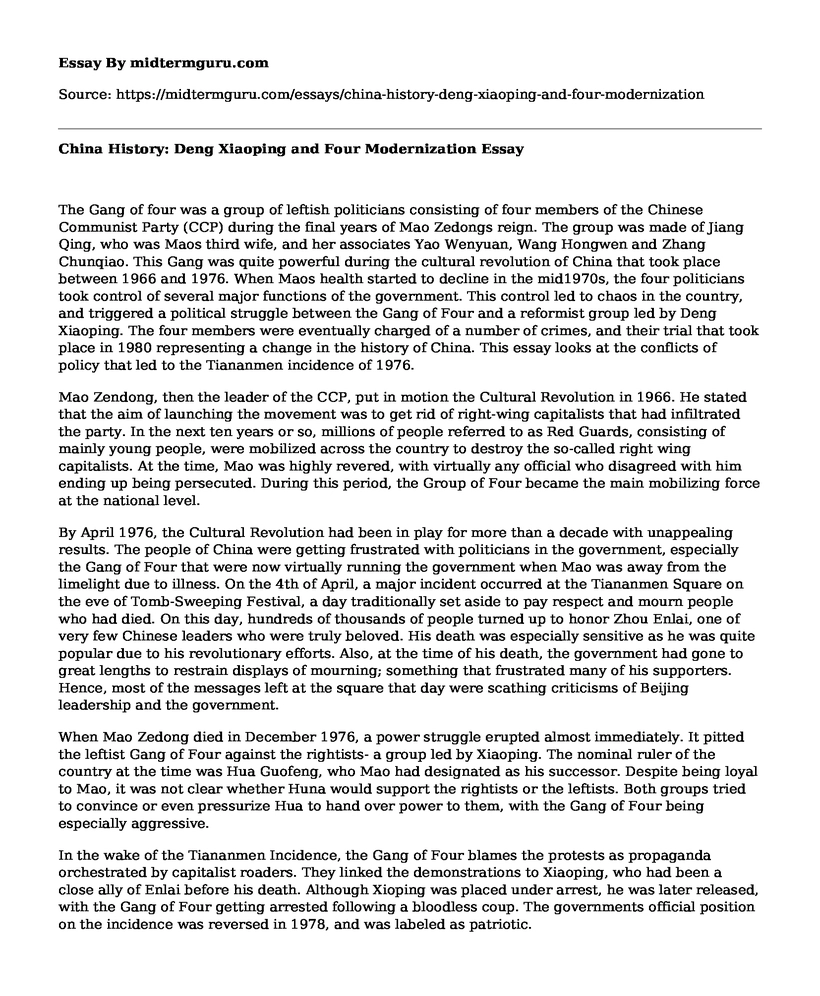The Gang of four was a group of leftish politicians consisting of four members of the Chinese Communist Party (CCP) during the final years of Mao Zedongs reign. The group was made of Jiang Qing, who was Maos third wife, and her associates Yao Wenyuan, Wang Hongwen and Zhang Chunqiao. This Gang was quite powerful during the cultural revolution of China that took place between 1966 and 1976. When Maos health started to decline in the mid1970s, the four politicians took control of several major functions of the government. This control led to chaos in the country, and triggered a political struggle between the Gang of Four and a reformist group led by Deng Xiaoping. The four members were eventually charged of a number of crimes, and their trial that took place in 1980 representing a change in the history of China. This essay looks at the conflicts of policy that led to the Tiananmen incidence of 1976.
Mao Zendong, then the leader of the CCP, put in motion the Cultural Revolution in 1966. He stated that the aim of launching the movement was to get rid of right-wing capitalists that had infiltrated the party. In the next ten years or so, millions of people referred to as Red Guards, consisting of mainly young people, were mobilized across the country to destroy the so-called right wing capitalists. At the time, Mao was highly revered, with virtually any official who disagreed with him ending up being persecuted. During this period, the Group of Four became the main mobilizing force at the national level.
By April 1976, the Cultural Revolution had been in play for more than a decade with unappealing results. The people of China were getting frustrated with politicians in the government, especially the Gang of Four that were now virtually running the government when Mao was away from the limelight due to illness. On the 4th of April, a major incident occurred at the Tiananmen Square on the eve of Tomb-Sweeping Festival, a day traditionally set aside to pay respect and mourn people who had died. On this day, hundreds of thousands of people turned up to honor Zhou Enlai, one of very few Chinese leaders who were truly beloved. His death was especially sensitive as he was quite popular due to his revolutionary efforts. Also, at the time of his death, the government had gone to great lengths to restrain displays of mourning; something that frustrated many of his supporters. Hence, most of the messages left at the square that day were scathing criticisms of Beijing leadership and the government.
When Mao Zedong died in December 1976, a power struggle erupted almost immediately. It pitted the leftist Gang of Four against the rightists- a group led by Xiaoping. The nominal ruler of the country at the time was Hua Guofeng, who Mao had designated as his successor. Despite being loyal to Mao, it was not clear whether Huna would support the rightists or the leftists. Both groups tried to convince or even pressurize Hua to hand over power to them, with the Gang of Four being especially aggressive.
In the wake of the Tiananmen Incidence, the Gang of Four blames the protests as propaganda orchestrated by capitalist roaders. They linked the demonstrations to Xiaoping, who had been a close ally of Enlai before his death. Although Xioping was placed under arrest, he was later released, with the Gang of Four getting arrested following a bloodless coup. The governments official position on the incidence was reversed in 1978, and was labeled as patriotic.
Bibliography
Amin, K., 2015. THE PEOPLE'S REPUBLIC OF CHINA UNDER MAO ZEDONG: POLICIES AND PROCEDURES. The AYER, 3, pp.316-323.
Callahan, W.A., 2015. History, Tradition and the China Dream: socialist modernization in the World of Great Harmony. Journal of Contemporary China, 24(96), pp.983-1001.
Gregor, A.J., 2014. The Ideology of Post-Maoist China. In Marxism and the Making of China (pp. 211-236). Palgrave Macmillan US.
Wang, Z., 2014. The Chinese dream: concept and context. Journal of Chinese Political Science, 19(1), pp.1-13.
Cite this page
China History: Deng Xiaoping and Four Modernization. (2021, May 19). Retrieved from https://midtermguru.com/essays/china-history-deng-xiaoping-and-four-modernization
If you are the original author of this essay and no longer wish to have it published on the midtermguru.com website, please click below to request its removal:
- Salvation by Langston Hughes and Her Socialist Years by Helen Keller - Reaction Paper Example
- The Development, Colonization and Gradual Resurgence of Latin America - History Paper Example
- Essay Sample on John Muir: A Lifelong Romance With Nature
- Essay on Understanding Critical Infrastructure and Border Security
- Critical Essay on Dr Martin Luther King's Speeches and Letters
- The Depiction of African Colonialism by Achebe and Conrad - Paper Example
- Trump's Tax Reforms: Promises Fulfilled After 3 Decades - Essay Sample







